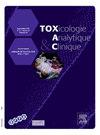IF 1.8
Q4 TOXICOLOGY
引用次数: 0
摘要
目标山区和高海拔地区通常是事故和死亡率较高的环境。在这些地区,氧气供应减少,空气稀薄,气温更低,紫外线水平升高。在法国,2014 年非法药物(大麻除外)的使用率为 1.8%,到 2023 年将上升至 3.9%。使用最广泛的毒品是大麻,根据法国毒品和犯罪问题办公室的数据,2023 年的使用率为 10.8%,在过去十年中保持稳定。因此,本研究旨在评估麻醉品和精神药物在法国阿尔卑斯山致命事故中的使用率。方法这项回顾性研究涉及法医尸检,参考了毒理学专家在 2014 年至 2023 年期间对法国阿尔卑斯山致命事故进行的 10 年尸检。收集的数据包括涉及下坡滑雪(滑雪场内和滑雪场外)、滑雪旅行、单板滑雪、滑翔伞、翼装飞行、飞机、直升机、滑翔机、徒步旅行、雪鞋运动、溪降运动、皮划艇、攀岩、登山、跑步、山地自行车、自行车运动和高空聚会的事故。结果2014年至2023年期间,阿尔卑斯山共有121人死于高空事故(99名男性和22名女性,年龄在10岁至86岁之间,平均年龄为43岁)。在这些案例中,没有一例涉及大麻以外的麻醉品或重大精神作用药物。9起案件涉及大麻,9名男性的年龄在17至49岁之间,平均年龄为28岁。1 例发生在 2015 年,3 例发生在 2016 年,3 例发生在 2022 年,2 例发生在 2023 年。9 例中有 3 例未考虑这种麻醉剂的影响,因为只有尿液或胆汁样本呈阳性。其他 6 个病例的血液中四氢大麻酚浓度为 0.53 至 4.6 纳克/毫升,四氢大麻酚-OH 浓度(当这种代谢物被鉴定出来时)为 0.7 至 1.9 纳克/毫升,四氢大麻酚-COOH 浓度为 3.1 至 24.2 纳克/毫升。在这 6 例死亡病例中,有 3 例是在下坡滑雪、越野滑雪和滑雪旅游时发生的意外事故,1 例是溪降事故,1 例是飞机驾驶员事故,1 例是在高海拔地区聚会时发生的事故。最后,10 年来,在这些高海拔地区事故中死亡的人中,有 5.0% 的人是在麻醉剂的影响下死亡的,而在这些病例中,大麻占了 100%。这些结果应与 DRAMES 国家调查中获得的结果进行比较,后者描述了 2014 年至 2022 年间大麻在间接死亡中的流行率,从 50% 到 78%不等,9 年间平均为 63%(addictovigilance.fr)。另一项于 2016 年在两家勃朗峰避难所的客户中进行的研究表明,麻醉品的流行率分别为 2.2% 和 3.3%,尤其是大麻的流行率分别为 4.6% 和 2.6% [1]。结论这项历时 10 年的回顾性研究表明,大麻是在高海拔地区致命事故中发现的唯一麻醉品,是一个额外的风险因素。本文章由计算机程序翻译,如有差异,请以英文原文为准。
Fatal accidents at high altitude and cannabis use: A 10-year retrospective study in the French Alps
Aim
Mountains and high altitudes in general are environments with a high accident and fatality rate. In these areas, oxygen availability is reduced, air is thinner, temperatures are colder, and UV levels are increased. In France, the use of illicit drugs (other than cannabis) was 1.8% in 2014 and has risen to 3.9% in 2023. The most widely used drug is cannabis, with a prevalence of use of 10.8% in 2023 and stable over the last ten years according to OFDT. The aim of this study is therefore to assess the prevalence of narcotics and psychoactive drugs in fatal accidents in the French Alps.
Method
This retrospective study concerns 10 years of forensic autopsies with reference toxicological expertise, following fatal accidents occurring in the French Alps between 2014 and 2023. The data collected includes accidents involving downhill skiing (on- and off-piste), ski touring, snowboarding, paragliding, wingsuiting, aeroplanes, helicopters, gliders, hiking, snowshoeing, canyoning, kayaking, climbing, mountaineering, running, mountain biking, cycling and parties at altitude.
Results
Between 2014 and 2023, a total of 121 people in the Alps died in accidents at altitude (99 men and 22 women, aged between 10 and 86, with an average age of 43). None of these cases involved narcotics other than cannabis or significant psychoactive drugs. Nine cases involved cannabis, 9 men aged between 17 and 49, with an average age of 28. One case occurred in 2015, 3 in 2016, 3 in 2022 and 2 in 2023. The influence of this narcotic was not considered for 3 of the 9 cases because only urine or bile samples were positive. The other 6 cases had blood THC concentrations ranging from 0.53 to 4.6 ng/mL, THC-OH concentrations, when this metabolite was identified, ranging from 0.7 to 1.9 ng/mL, and THC-COOH concentrations ranging from 3.1 to 24.2 ng/mL. Of these 6 cases, 3 deaths were the result of accidents while downhill on-piste skiing, off-piste skiing and ski touring, 1 canyoning accident, 1 aircraft pilot accident and 1 accident during a party at altitude.
Finally, over 10 years, 5.0% of people who died in these accidents at high altitude were under the influence of a narcotic, and cannabis accounted for 100% of these cases. These results are to be compared with those obtained in the national DRAMES survey, which describes the prevalence of cannabis in indirect deaths as ranging from 50 to 78% between 2014 and 2022, with an average of 63% over 9 years (addictovigilance.fr). Another study carried out in 2016 among clients of two Mont Blanc refuges describes a prevalence of narcotics of 2.2 and 3.3% and more particularly cannabis of 4.6 and 2.6% [1].
Conclusion
This retrospective study over 10 years shows that cannabis is the only narcotic found in fatal accidents at high altitude, constituting an additional risk factor.
求助全文
通过发布文献求助,成功后即可免费获取论文全文。
去求助

 求助内容:
求助内容: 应助结果提醒方式:
应助结果提醒方式:


